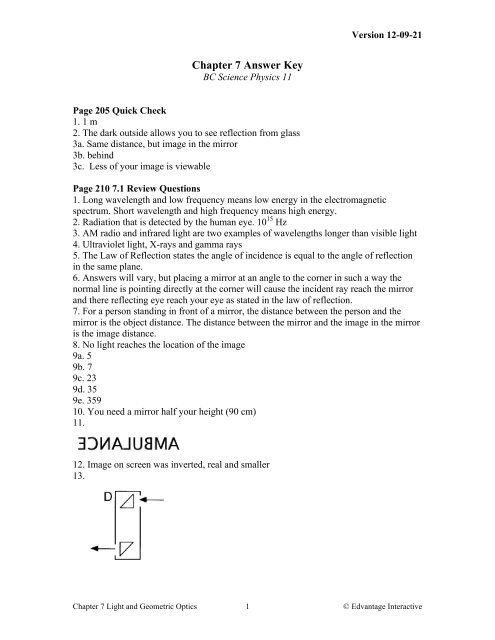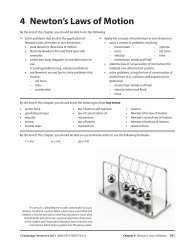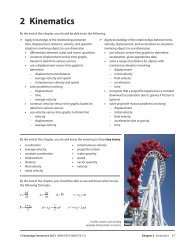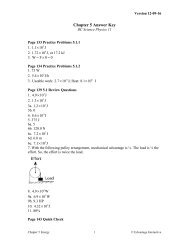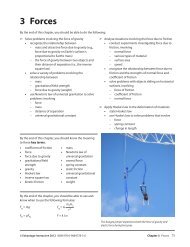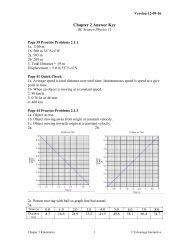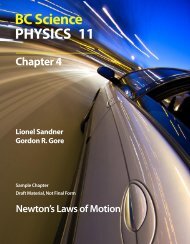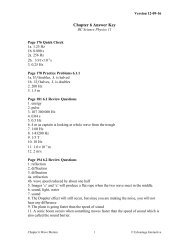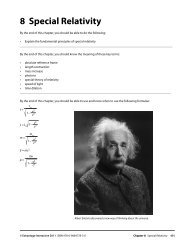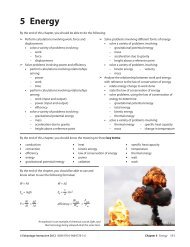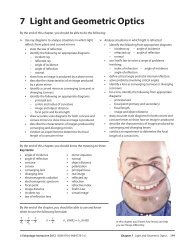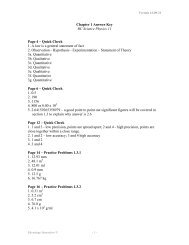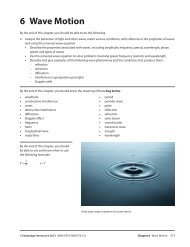Chapter 7 Answer Key - BC Science Physics 11
Chapter 7 Answer Key - BC Science Physics 11
Chapter 7 Answer Key - BC Science Physics 11
You also want an ePaper? Increase the reach of your titles
YUMPU automatically turns print PDFs into web optimized ePapers that Google loves.
<strong>Chapter</strong> 7 <strong>Answer</strong> <strong>Key</strong><br />
<strong>BC</strong> <strong>Science</strong> <strong>Physics</strong> <strong>11</strong><br />
Page 205 Quick Check<br />
1. 1 m<br />
2. The dark outside allows you to see reflection from glass<br />
3a. Same distance, but image in the mirror<br />
3b. behind<br />
3c. Less of your image is viewable<br />
Version 12-09-21<br />
Page 210 7.1 Review Questions<br />
1. Long wavelength and low frequency means low energy in the electromagnetic<br />
spectrum. Short wavelength and high frequency means high energy.<br />
2. Radiation that is detected by the human eye. 10 15 Hz<br />
3. AM radio and infrared light are two examples of wavelengths longer than visible light<br />
4. Ultraviolet light, X-rays and gamma rays<br />
5. The Law of Reflection states the angle of incidence is equal to the angle of reflection<br />
in the same plane.<br />
6. <strong>Answer</strong>s will vary, but placing a mirror at an angle to the corner in such a way the<br />
normal line is pointing directly at the corner will cause the incident ray reach the mirror<br />
and there reflecting eye reach your eye as stated in the law of reflection.<br />
7. For a person standing in front of a mirror, the distance between the person and the<br />
mirror is the object distance. The distance between the mirror and the image in the mirror<br />
is the image distance.<br />
8. No light reaches the location of the image<br />
9a. 5<br />
9b. 7<br />
9c. 23<br />
9d. 35<br />
9e. 359<br />
10. You need a mirror half your height (90 cm)<br />
<strong>11</strong>.<br />
12. Image on screen was inverted, real and smaller<br />
13.<br />
<strong>Chapter</strong> 7 Light and Geometric Optics 1 © Edvantage Interactive
Page 215 Quick Check<br />
1a. real, inverted, smaller between C and F<br />
1b. real, inverted, same size, at C<br />
1c. Real, inverted, enlarged beyond C<br />
Page 218 Practice Problems 7.2.1<br />
1. 100 cm<br />
2. D = 2f<br />
3. 13.3 cm<br />
4. di = -30.0 cm The image is virtual and appears behind the mirror<br />
Version 12-09-21<br />
Page 223 7.2 Review Questions<br />
**Note for questions 1 and 2, lens should be changed to mirror<br />
1. A convex mirror curves out and a concave mirror curves inwards<br />
2. A convex mirror is a converging mirror and a concave mirror is a diverging mirror<br />
3. Concave<br />
4a. Concave<br />
4b. Convex<br />
4c. Plane<br />
5. E, A, F,B, D, C<br />
6a. Far away: Inverted, real, smaller, between C and F<br />
6b. Outside C: Inverted, real, smaller, between C and F<br />
6c. At C: Inverted, real, same size and at C<br />
6d. At focal point: No image formed<br />
6e. Between focal point and vertex: Upright, virtual, larger, behind mirror<br />
7a. To come<br />
7b. To come<br />
7c. To come<br />
7d. To come<br />
9. Image to come, image will be upright, virtual, smaller and behind the mirror.<br />
10a. No, all convex mirror images are virtual<br />
10b. No, an image gets larger as an object gets closer to the mirror, but the image is never<br />
larger.<br />
Challenge<br />
1. Image to come<br />
Page 228 Quick Check<br />
1. 1.54<br />
2. ∠r = 4.<strong>11</strong>°<br />
3a. ∠r = 19.5°<br />
3b. Light enters the glass at 30 o from the normal, then refracts within the glass at 20 o from<br />
the normal. When it leaves the glass it goes back into air, it will be at 30 o from the normal<br />
again.<br />
4. Prism, Violet refracts most.<br />
<strong>Chapter</strong> 7 Light and Geometric Optics 2 © Edvantage Interactive
Page 230 Quick Check<br />
1. i = 24.4°<br />
c<br />
2. i = 41.8°<br />
c<br />
3. n = 1.27<br />
Page 237 7.3 Review Questions<br />
Version 12-09-21<br />
1. Incident angle is 70 o , which is greater than the critical angle, so this particular ray will<br />
reflect back into the water. Some rays will refract out at other angle and reach the fisher’s<br />
eyes.<br />
2a. Below<br />
2b. Aim at what you see. The laser refracts light too.<br />
3.<br />
4. 39.3 o<br />
5. 600 nm<br />
6. 1.23 x 10 8 m/s<br />
7.<br />
8. Water is pure, light is coming from a vacuum or air, and the frequency is for ‘average’<br />
visible light.<br />
9a. refraction, dispersion and total internal reflection<br />
9b. Sun behind you and rainclouds in front of you<br />
9c. red, orange, yellow, green, blue, indigo, violet.<br />
10. All the same speed in a vacuum. Red is fastest in glass.<br />
<strong>11</strong>. 2.0 ×10 8 m/s<br />
<strong>Chapter</strong> 7 Light and Geometric Optics 3 © Edvantage Interactive
12. 1.54<br />
14a. 489 nm<br />
14b. blue<br />
14c. Frequency determines colour<br />
Page 242 Quick Check<br />
1. To come<br />
2. To come<br />
Page 244 Quick Check<br />
1. 50.5 mm<br />
2. 100 mm or 10.0 cm<br />
3. 20 mm<br />
Page 252 7.4 Review<br />
2a. -50.0 cm<br />
2b. a virtual image<br />
3. To come<br />
4. 1.90 cm<br />
5. Hi = 1.7 cm<br />
6. Magnification is 2.00, The image is real because Do > f<br />
7. To come<br />
8.<br />
Version 12-09-21<br />
9. Red eye is the flash reflecting off the retina. Most cameras flash twice. The first flash<br />
causes the pupil to contract and the second flash takes the picture. The smaller pupil<br />
reduces ‘red eye’.<br />
Page 254 <strong>Chapter</strong> 7 Review Questions<br />
4. 0.8 mm<br />
5. 7<br />
6. To get a wide angle view<br />
7. Place the filament between f and 2f<br />
8. Between the focus and mirror<br />
9. 1.7 m (real image)<br />
10. 2.0 m<br />
∠r = 21°<br />
<strong>11</strong>.<br />
The beam will lave the glass at 35°<br />
12. ∠i = 41.1°<br />
c<br />
<strong>Chapter</strong> 7 Light and Geometric Optics 4 © Edvantage Interactive
13. To come<br />
14. n=1/sin45°=1.41<br />
15. The shorter the wavelength (violet) the more the ray bends<br />
16. 1.5×10 8 m/s<br />
17a. The graph is a straight line through 0,0<br />
17b. Slope is 1.50 (n=1.50)<br />
17c. 41.8 o<br />
18. Wrong lens to focus light<br />
19a. Do is greater than 2f<br />
19b. Do is between f and 2f<br />
19c. Do = 2f<br />
19d. Do is much less than f<br />
20. Inverted, smaller, real image forms between C and F<br />
21. E<br />
22. 22.5 cm<br />
23. Inverted, enlarged, real image forms beyond C<br />
24. 12 mm<br />
25. 6.5 cm<br />
26. -55.9 cm<br />
Version 12-09-21<br />
<strong>Chapter</strong> 7 Light and Geometric Optics 5 © Edvantage Interactive


